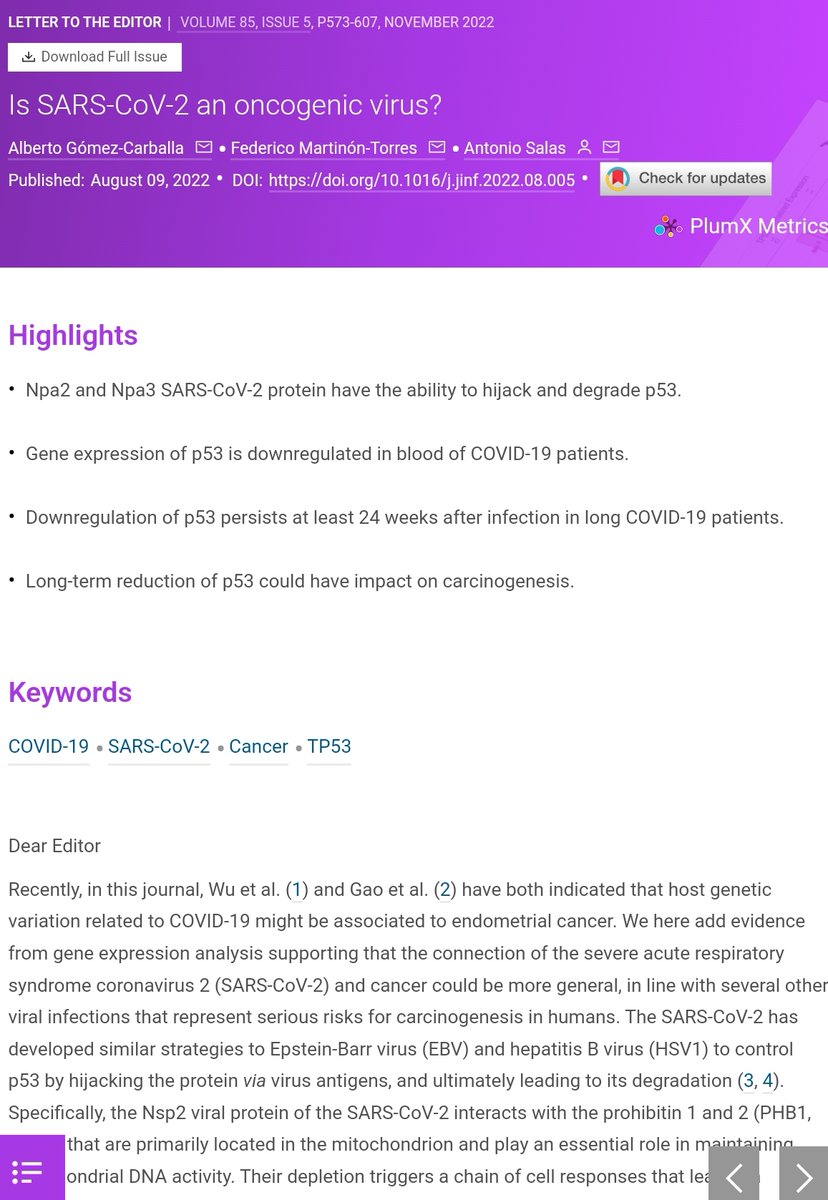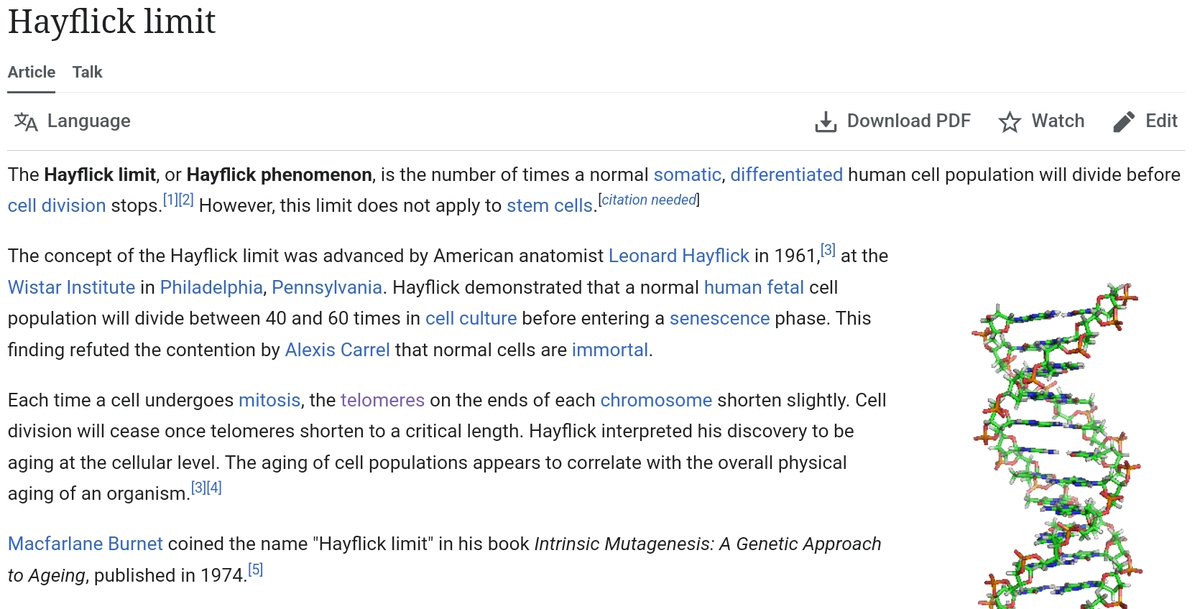SARS-CoV-2 in infected cells:
"Overall findings suggest that SARS-CoV-2 both induces DNA damage & impairs its repair"
seems this can be a #cancer accelerator & overwhelm the immune system w/ (pre)cancerous cells
combine that w/ v likely SC2 persistence
nature.com/articles/s4155…

"Overall findings suggest that SARS-CoV-2 both induces DNA damage & impairs its repair"
seems this can be a #cancer accelerator & overwhelm the immune system w/ (pre)cancerous cells
combine that w/ v likely SC2 persistence
nature.com/articles/s4155…

an older 🧵 concerning SARS-CoV-2 & cancer:
https://twitter.com/tohmes1/status/1583075915050864640?s=20
SARS-CoV-2, persistence & suppression of cell internal clearing-signals
results showed that SC2 infected cells had high expression of pre-apoptosis pathways, but low expression of final IFN-α. Consistent w/ SC2 subverting IFN signaling in infected cells
journals.asm.org/doi/10.1128/mb…

results showed that SC2 infected cells had high expression of pre-apoptosis pathways, but low expression of final IFN-α. Consistent w/ SC2 subverting IFN signaling in infected cells
journals.asm.org/doi/10.1128/mb…

SARS-CoV-2, IFN-α & cancer
IFN-α is a cytokine that mediates immune responses to infected cells & tumour cells
SC2 inhibits IFN-α expression. Thus SC2 infected cells evade needed cell-death & produce more virions. If some also become cancerous, they more likely multiply&persist
IFN-α is a cytokine that mediates immune responses to infected cells & tumour cells
SC2 inhibits IFN-α expression. Thus SC2 infected cells evade needed cell-death & produce more virions. If some also become cancerous, they more likely multiply&persist
SARS-CoV-2 & accelerating breast cancer
in addition to high risk of SC2 infection, cancer patients likely have higher risk of accelerated cancer progression after infection …
M protein TNBC cells caused malignant transformation of nonaggresive BCC …
frontiersin.org/articles/10.33…

in addition to high risk of SC2 infection, cancer patients likely have higher risk of accelerated cancer progression after infection …
M protein TNBC cells caused malignant transformation of nonaggresive BCC …
frontiersin.org/articles/10.33…

SARS-CoV-2 & melanoma
by showing that SC2 leads to STAT3 activation in breast cancer & as a cancer accelerator
the authors showed SC2 leads to STAT3 activation
STAT3 activation leads to many different kinds of cancer
for example: melanoma
nature.com/articles/s4141…

by showing that SC2 leads to STAT3 activation in breast cancer & as a cancer accelerator
the authors showed SC2 leads to STAT3 activation
STAT3 activation leads to many different kinds of cancer
for example: melanoma
nature.com/articles/s4141…

SARS-CoV-2 & liver cancer
it preferably infects malignant cells, & "endows" infected cells w/ mechanisms to avoid being detected by cancer fighting cells & pathways
it can persist w/ each infection
in GI tract &/or liver
it preferably infects malignant cells, & "endows" infected cells w/ mechanisms to avoid being detected by cancer fighting cells & pathways
it can persist w/ each infection
in GI tract &/or liver
https://twitter.com/tohmes1/status/1706437609881550853?t=8xDzJJiJJobZ3mh_I9H75A&s=19
A good overview paper of mechanisms
"Recent studies suggest pathogenetic mechanisms common for both SARS-CoV-2 and oncogenesis. SARS-CoV-2 exploits host immunity stimulates signalling and oncogenic pathways and may establish an oncogenic microenvironment"
frontiersin.org/articles/10.33…

"Recent studies suggest pathogenetic mechanisms common for both SARS-CoV-2 and oncogenesis. SARS-CoV-2 exploits host immunity stimulates signalling and oncogenic pathways and may establish an oncogenic microenvironment"
frontiersin.org/articles/10.33…

There is growing evidence of SARS-CoV-2 modulating oncogenic pathways, promoting chronic low-grade inflammation & causing tissue damage. Main relationships between SC2 & cancer are summarized, showing proposed biochemical cellular transformation mechanisms
ncbi.nlm.nih.gov/pmc/articles/P…

ncbi.nlm.nih.gov/pmc/articles/P…

1/2 Study reports possible hijacking of EGFR & related downstream signaling pathways by SARS-CoV-2 Spike 1 protein & its RBD in lung cancer cells (A549).
Also: Spike 1 & RBD also elicited the activation of a key marker for the survival of cancer cells.
mdpi.com/2076-393X/11/4…

Also: Spike 1 & RBD also elicited the activation of a key marker for the survival of cancer cells.
mdpi.com/2076-393X/11/4…

2/2 epidermal growth factor receptor (EGFR) is a growth factor receptor that induces cell differentiation & proliferation upon activation. In pathological settings, EGFR (overexpression) is a sign of growth-signal independence & a driver of tumorigenesis.
1/2 authors add evidence showing more general connection of SARS-CoV-2 and cancer, in line with several other carcinogenic viral infections.
I.e. p53 expression is downregulated in COVID-19 patients & persists at least 24 weeks in long COVID-19 patients.
journalofinfection.com/article/S0163-…

I.e. p53 expression is downregulated in COVID-19 patients & persists at least 24 weeks in long COVID-19 patients.
journalofinfection.com/article/S0163-…

2/2 cancer & p53, an anti-growth signal
Evasion of anti-growth signaling is an important characteristic of cancer cells. To continue to proliferate, cancer cells uncouple themselves from signals for slowing down cell growth.
One such pathway is p53.
ncbi.nlm.nih.gov/pmc/articles/P…

Evasion of anti-growth signaling is an important characteristic of cancer cells. To continue to proliferate, cancer cells uncouple themselves from signals for slowing down cell growth.
One such pathway is p53.
ncbi.nlm.nih.gov/pmc/articles/P…

17 genes were upregulated by SARS-CoV-2 e.g.: CCNB2, ESPL1, TTK, CCNA2, CCNB1, CDC6, CDC20, CDK1, BUB1, CHEK1, BUB1B, CDC45, PLK1, CCNA1, ORC1 & E2F1. This is linked to cancers of the breast, digestive tract, bone, endometrial, skin, brain, lung cancer ...
researchsquare.com/article/rs-189…

researchsquare.com/article/rs-189…

Paper gives an overview of strategies SARS-CoV-2 uses to potentially cause cancer stem cell to develop in different organs w/ focus on lung cancer, colorectal cancer, pancreatic adenocarcinoma, breast cancer, oral cancer
sciencedirect.com/science/articl…

sciencedirect.com/science/articl…

1/4 SARS-CoV-2 & angiogenesis
On a molecular level, COVID-19 hearts displayed a distinct expression gene pattern primarily coding for factors involved in angiogenesis & epithelial-mesenchymal transition (EMT), changes not seen in any other patient groups.
ncbi.nlm.nih.gov/pmc/articles/P…

On a molecular level, COVID-19 hearts displayed a distinct expression gene pattern primarily coding for factors involved in angiogenesis & epithelial-mesenchymal transition (EMT), changes not seen in any other patient groups.
ncbi.nlm.nih.gov/pmc/articles/P…

2/4 SARS-CoV-2 & angiogenesis
Results show COVID-19 was associated w/ increased immunoexpression of biomarkers involved in endothelial dysfunction, microthrombosis, & angiogenesis compared to the H1N1 and CONTROL groups.
ncbi.nlm.nih.gov/pmc/articles/P…

Results show COVID-19 was associated w/ increased immunoexpression of biomarkers involved in endothelial dysfunction, microthrombosis, & angiogenesis compared to the H1N1 and CONTROL groups.
ncbi.nlm.nih.gov/pmc/articles/P…

3/4 SARS-CoV-2 & angiogenesis
vascular injuries accompanied by thrombosis, vasoconstriction & distinct intussusceptive angiogenesis, a rapid process of blood vessel neoformation by splitting a vessel by an incorporation of circulating angiogenic cells
erj.ersjournals.com/content/56/5/2…
vascular injuries accompanied by thrombosis, vasoconstriction & distinct intussusceptive angiogenesis, a rapid process of blood vessel neoformation by splitting a vessel by an incorporation of circulating angiogenic cells
erj.ersjournals.com/content/56/5/2…
4/4 angiogenesis & cancer
Angiogenesis is the growth of blood vessels from existing vasculature. It plays a critical role in cancer growth b/c solid tumors need a blood supply. Tumors can cause such blood supplies to form by giving off signals that stimulate angiogenesis.
Angiogenesis is the growth of blood vessels from existing vasculature. It plays a critical role in cancer growth b/c solid tumors need a blood supply. Tumors can cause such blood supplies to form by giving off signals that stimulate angiogenesis.
this thread 👆 is part of a more general thread 👇 that goes through all of the "Hallmarks of Cancer" and if SARS-CoV-2 infected cells fulfill all of the hallmarks
https://twitter.com/tohmes1/status/1724476105212760100?t=9w_MGOwWIHKhB6_WN3AZVA&s=19
excellent paper detailing many of the pathways how SARS-CoV-2 can cause/accelerate cancer
Keywords: infected immunesystem cells, compromised anti-tumoral immune responses, pro-tumoral inflammation, direct oncogenic impacts, oncovirus reactativation
ncbi.nlm.nih.gov/pmc/articles/P…

Keywords: infected immunesystem cells, compromised anti-tumoral immune responses, pro-tumoral inflammation, direct oncogenic impacts, oncovirus reactativation
ncbi.nlm.nih.gov/pmc/articles/P…

• • •
Missing some Tweet in this thread? You can try to
force a refresh















